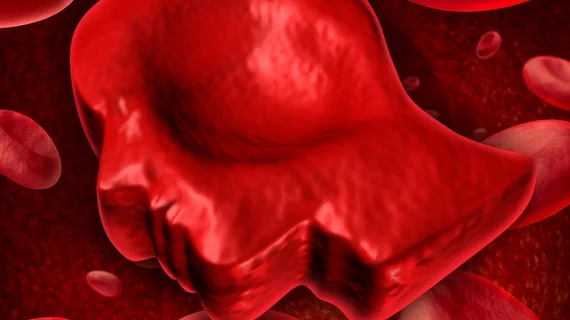New risk score distinguishes inpatient strokes from other conditions
Researchers from Northwestern University developed an easy-to-calculate, four-factor score which identified 92.2 percent of true strokes among 330 inpatients who triggered stroke alerts. This could prove a useful tool, they said, considering about a quarter of acute strokes occur in patients hospitalized for another reason and stroke symptoms can be confused with other conditions such as seizures or delirium.
“During inpatient stroke codes, the 2CAN score may help a non-neurologist quickly assess the probability that inpatient with neurological symptoms is having a stroke,” wrote lead author Philip Chang, MD, and colleagues with the Department of Neurology at Northwestern University Feinberg School of Medicine. They published their findings online Oct. 24 in Stroke.
“Since many patients admitted to a hospital do not have access to rapid in-person neurology consultation at times of acute inpatient stroke, a scoring tool may be useful to ensure prompt responses by appropriate teams.”
Chang et al. developed the tool in consecutive patients who had a stroke code activated during admissions at Northwestern Memorial Hospital from September 2014 through July 2016. Of the 330 patients, 35.2 percent had a stroke confirmed through imaging and expert neurologist assessment, 13 percent had a neurological mimic such as a seizure and 51.8 percent had a non-neurological mimic such as encephalopathy.
After multivariable adjustment, four factors were independently associated with stroke and were later used in the 2CAN stroke detection tool:
- The clinical deficit score (CDS), which was derived from five items in the National Institutes of Health stroke scale score. A positive CDS was linked to 6.30-fold odds of stroke.
- New admissions, defined as being less than 24 hours into a hospital admission (adjusted odds ratio for stroke: 3.51).
- Being postoperative following a cardiac procedure (adjusted OR: 5.93).
- History of atrial fibrillation (adjusted OR: 3.23).
Each factor was assigned one point in the 2CAN score, except for a CDS of two or higher, which was assigned three points.
The 2CAN score achieved an area under the curve (AUC) of 0.93 in the validation cohort—the first 165 patients in the study—and an AUC of 0.88 in the next 165 patients. When the patients were combined into a single group, a 2CAN score of two or greater demonstrated 92.2 percent sensitivity and 69.6 percent specificity for identifying stroke. It also had a positive predictive value of 62.2 percent and a negative predictive value of 94.3 percent.
Put another way, a 2CAN score of two or higher identified 107 of 116 true strokes in the total cohort, while only 5.7 percent of patients below that threshold suffered true strokes.
The researchers noted a quick-scoring system to help non-neurology providers distinguish true strokes has been developed for emergency departments, but currently no such tools exist for the inpatient setting. Almost paradoxically, they said there is evidence that “patients with inpatient strokes experience significantly greater delays to treatment and computed tomography scan compared with patients experiencing strokes out of the hospital.” They said delayed recognition by non-neurology providers is a likely explanation for this finding.
“A stroke recognition tool may be useful to help detect strokes in the inpatient setting, hasten diagnosis, and increase the proportion of patients eligible for acute reperfusion therapy,” the authors wrote. “This is especially true with recent guidelines recommending thrombectomy up to 24 hours after stroke onset in some patients.
“Further prospective validation of our findings in multiple academic and community centers where the CDS can be directly applied by non-neurology providers is warranted to ensure reliability of the score in different clinical settings.”

